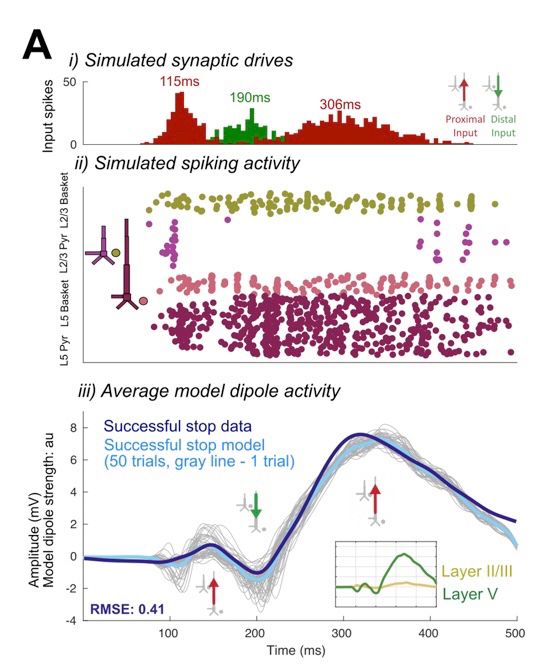
Darcy Waller
@darcywaller.bsky.social
Postdoc at Brown using biophysical computational modeling + cog neuro methods to understand inhibitory control mechanisms in health and disease. 🧠🛑 (she/her)
👎🏻😢 M/EEG analysis gifs are a critical user feature
November 3, 2023 at 3:57 PM
👎🏻😢 M/EEG analysis gifs are a critical user feature
Thanks for reading and we’re looking forward to hearing what reviewers and colleagues think! (8/8)
October 31, 2023 at 2:09 AM
Thanks for reading and we’re looking forward to hearing what reviewers and colleagues think! (8/8)
We hope these predictions are exciting, useful to those wanting to better connect mechanism with behavior in the stop signal task. I’m also v excited about potential for HNN models to generate similar predictions w/ FC-ERPs in other contexts (ERN, RewP, oddball P3, etc.) (7/)
October 31, 2023 at 2:09 AM
We hope these predictions are exciting, useful to those wanting to better connect mechanism with behavior in the stop signal task. I’m also v excited about potential for HNN models to generate similar predictions w/ FC-ERPs in other contexts (ERN, RewP, oddball P3, etc.) (7/)
Check out all the other fun details in the preprint, including alt models addressing: can anything else explain P3 diff? What’s going on with P2/N2 mechanisms? What if different parts of the FC-ERP come from different columns?? (6/)
October 31, 2023 at 2:08 AM
Check out all the other fun details in the preprint, including alt models addressing: can anything else explain P3 diff? What’s going on with P2/N2 mechanisms? What if different parts of the FC-ERP come from different columns?? (6/)
Our modeling also predicted mechanisms producing ERP feature diffs between successful, failed stops. Thalamocortical drive producing the P3 is later, but not weaker, in failed stops, in line w/ race model prediction of a later but not weaker Stop process. (5/)

October 31, 2023 at 2:08 AM
Our modeling also predicted mechanisms producing ERP feature diffs between successful, failed stops. Thalamocortical drive producing the P3 is later, but not weaker, in failed stops, in line w/ race model prediction of a later but not weaker Stop process. (5/)
To assess, we used @HNNsolver’s biophys model of a cortical column under external drive to predict mechanisms of the FC-ERP features after the stop signal (P2, N2, P3). A sequence of drives strikingly similar to those proposed to produce sensory ERPs can accomplish this. (4/)

October 31, 2023 at 2:07 AM
To assess, we used @HNNsolver’s biophys model of a cortical column under external drive to predict mechanisms of the FC-ERP features after the stop signal (P2, N2, P3). A sequence of drives strikingly similar to those proposed to produce sensory ERPs can accomplish this. (4/)
Such interpretation is 🔑 in hypotheses about meaning of ERP features in the stop-signal task (esp wrt the horse race model’s Stop process). P3 onset is proposed to index Stop because of early timing when stops successful, but unclear if mechs support this link. (3/)
October 31, 2023 at 2:06 AM
Such interpretation is 🔑 in hypotheses about meaning of ERP features in the stop-signal task (esp wrt the horse race model’s Stop process). P3 onset is proposed to index Stop because of early timing when stops successful, but unclear if mechs support this link. (3/)
Frontocentral ERPs (FC-ERPs) are proxy signals of cognitive control processes. But, we don’t know if grand average ERP behavior = similar behavior of underlying mechanisms, given complex cortical dynamics. This is a problem for theoretical interpretation. (2/)
October 31, 2023 at 2:05 AM
Frontocentral ERPs (FC-ERPs) are proxy signals of cognitive control processes. But, we don’t know if grand average ERP behavior = similar behavior of underlying mechanisms, given complex cortical dynamics. This is a problem for theoretical interpretation. (2/)

